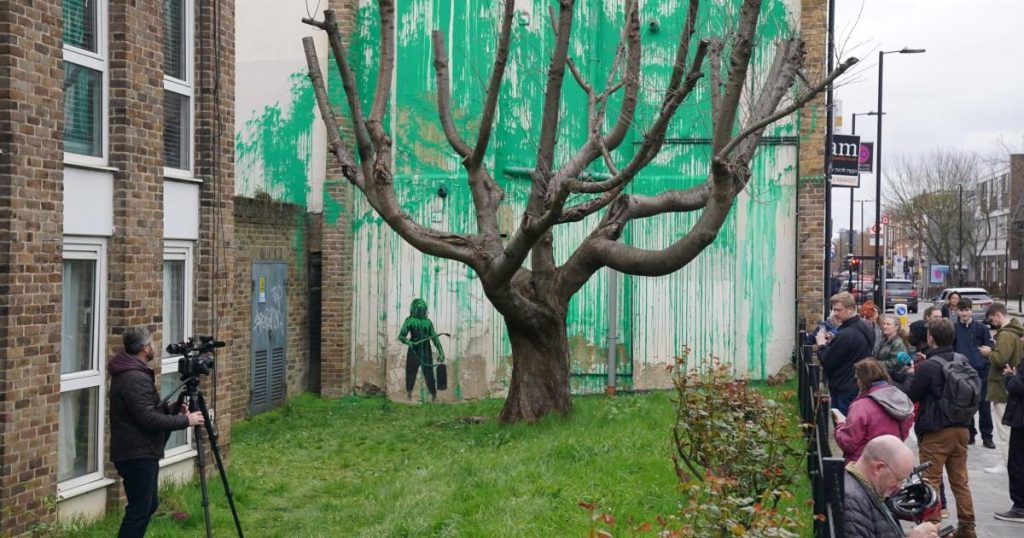The enigmatic graffiti artist Banksy, renowned for his anonymity and politically charged artwork, finds himself in the midst of a legal battle that threatens to unravel the carefully constructed veil of secrecy surrounding his identity. A greeting card company, Full Colour Black, is challenging Banksy’s trademark of his own name, arguing that it hasn’t been genuinely used for commercial purposes and should therefore be cancelled. This seemingly mundane legal dispute carries significant implications, as it could force a member of Banksy’s team to testify publicly for the first time, potentially offering a rare glimpse into the inner workings of the artist’s operations.
The core of the dispute revolves around the concept of trademark “use.” Banksy maintains that he has utilized his trademarked name to sell artwork and merchandise, while Full Colour Black contends that such use has been insufficient to justify maintaining the trademark. The legal proceedings, scheduled for the Intellectual Property Office in April, will require Banksy’s team to present evidence substantiating their claim of trademark use. This presents a unique challenge for the notoriously secretive artist, whose public pronouncements typically occur through his Instagram account or via his authentication and handling service, Pest Control Office. The prospect of a representative speaking on Banksy’s behalf in a formal legal setting adds an unprecedented layer of intrigue to the proceedings.
Banksy, in a rare public statement, has framed the dispute as an attempt by the greeting card company to capitalize on his name and reputation. He accuses Full Colour Black of seeking to “take custody” of his name to legitimize the sale of “fake Banksy merchandise.” Pest Control Online, which authenticates and sells Banksy artwork, counters this claim by asserting they have indeed sold various items, including clocks, cushions, mugs, t-shirts, and even a handbag, through their online store, demonstrating an active commercial use of the Banksy brand. However, the crux of the legal argument seems to lie in whether the “Banksy” trademark itself has been prominently used on these items or whether the sales primarily leverage the imagery and recognition associated with Banksy’s artistic creations.
The case has drawn attention to the complexities surrounding Banksy’s commercial activities and his approach to intellectual property. Critics argue that Banksy’s ownership of the trademark stifles competition and grants Pest Control excessive power within the art market. They point to the widespread descriptive use of the name “Banksy” in reference to the artist’s style and subject matter, suggesting it has become a generic term rather than a distinct brand identifier. This argument echoes previous legal challenges to Banksy’s trademarks for specific artworks, including “Flower Thrower,” “Radar Rat,” and “Girl with Umbrella,” which he lost after an EU panel ruled he had filed them in bad faith, lacking a genuine intention to commercialize the images.
Adding another layer of complexity to the legal landscape surrounding Banksy is a separate defamation lawsuit filed by Andrew Gallagher, the owner of Full Colour Black. This lawsuit stems from an Instagram post by Banksy allegedly encouraging shoplifting from the Regent Street branch of GUESS, a fashion brand accused of using Banksy’s artwork without permission. The post, which urged shoplifters to target GUESS, ignited controversy and raises questions about the legal ramifications of such public pronouncements. The interconnectedness of these legal battles highlights the precarious balance Banksy must strike between protecting his artistic legacy and navigating the complexities of intellectual property law.
The upcoming tribunal promises to be a fascinating spectacle, potentially shedding light on the carefully guarded world of Banksy and his business practices. The necessity of presenting evidence of trademark use could unveil previously unknown details about the artist’s commercial activities. Furthermore, the potential for a representative to speak publicly on Banksy’s behalf raises the tantalizing possibility, however remote, of gaining insight into the artist’s identity or, at the very least, the workings of the organization surrounding him. The case underscores the tension inherent in Banksy’s anonymous persona: the desire to maintain anonymity while simultaneously protecting his artistic output and brand in a legal framework designed for transparency. The outcome of this legal battle could have significant implications for Banksy’s future ability to control his brand and navigate the commercial art world.


